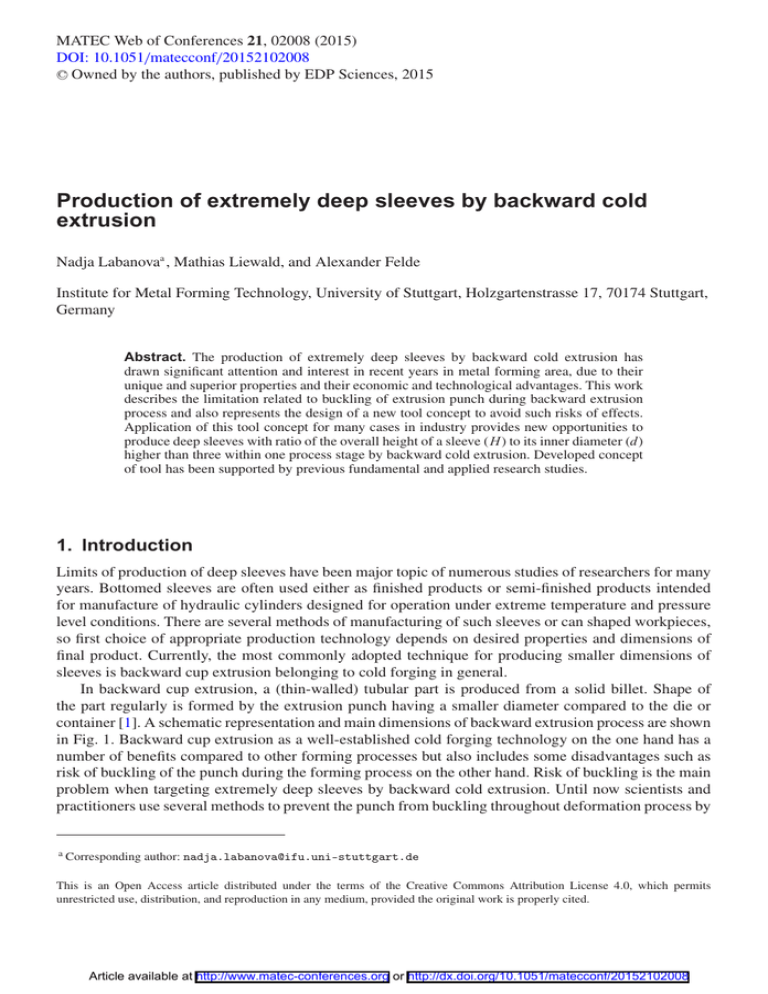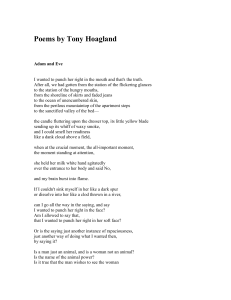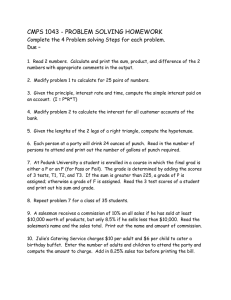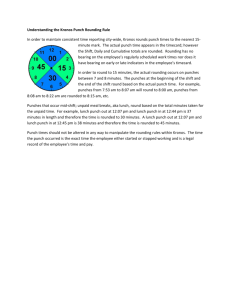Production of extremely deep sleeves by backward cold extrusion
advertisement

MATEC Web of Conferences 21, 02008 (2015) DOI: 10.1051/matecconf/20152102008 C Owned by the authors, published by EDP Sciences, 2015 Production of extremely deep sleeves by backward cold extrusion Nadja Labanovaa , Mathias Liewald, and Alexander Felde Institute for Metal Forming Technology, University of Stuttgart, Holzgartenstrasse 17, 70174 Stuttgart, Germany Abstract. The production of extremely deep sleeves by backward cold extrusion has drawn significant attention and interest in recent years in metal forming area, due to their unique and superior properties and their economic and technological advantages. This work describes the limitation related to buckling of extrusion punch during backward extrusion process and also represents the design of a new tool concept to avoid such risks of effects. Application of this tool concept for many cases in industry provides new opportunities to produce deep sleeves with ratio of the overall height of a sleeve (H ) to its inner diameter (d) higher than three within one process stage by backward cold extrusion. Developed concept of tool has been supported by previous fundamental and applied research studies. 1. Introduction Limits of production of deep sleeves have been major topic of numerous studies of researchers for many years. Bottomed sleeves are often used either as finished products or semi-finished products intended for manufacture of hydraulic cylinders designed for operation under extreme temperature and pressure level conditions. There are several methods of manufacturing of such sleeves or can shaped workpieces, so first choice of appropriate production technology depends on desired properties and dimensions of final product. Currently, the most commonly adopted technique for producing smaller dimensions of sleeves is backward cup extrusion belonging to cold forging in general. In backward cup extrusion, a (thin-walled) tubular part is produced from a solid billet. Shape of the part regularly is formed by the extrusion punch having a smaller diameter compared to the die or container [1]. A schematic representation and main dimensions of backward extrusion process are shown in Fig. 1. Backward cup extrusion as a well-established cold forging technology on the one hand has a number of benefits compared to other forming processes but also includes some disadvantages such as risk of buckling of the punch during the forming process on the other hand. Risk of buckling is the main problem when targeting extremely deep sleeves by backward cold extrusion. Until now scientists and practitioners use several methods to prevent the punch from buckling throughout deformation process by a Corresponding author: nadja.labanova@ifu.uni-stuttgart.de This is an Open Access article distributed under the terms of the Creative Commons Attribution License 4.0, which permits unrestricted use, distribution, and reproduction in any medium, provided the original work is properly cited. Article available at http://www.matec-conferences.org or http://dx.doi.org/10.1051/matecconf/20152102008 MATEC Web of Conferences Figure 1. Schematic representation and main dimensions of backward extrusion process. reducing compression stress as far as possible, but tool material of punch of course limits such extreme applications. In this paper, technological limitations related to risk of buckling and a new method of prevention such extreme compression load during backward cup extrusion are described and analysed. Furthermore, the design of a new tool, which can avoid risk of buckling throughout the forming process, for production of deep steel sleeves (H /d>4) within one single process stage by backward cup extrusion and experimental results obtained by applying this tool are introduced here. 2. Risk of buckling of the punch during backward cup extrusion Backward cup extrusion has a lot of different fields of applications, some advantages over other production techniques, and is a suitable method for manufacturing products such as tubes, cans, sleeves etc. Some advantages of this method are optimal usage of material, high production rates with short piece-production times, accurate reproduction of dimensions and workpiece shape coupled with good surface quality, and good static and dynamic properties of the components due to the favourable fibre structure and work hardening. Backward cup extrusion has significant capabilities, although, there are some limitations. The crucial criterion for applying backward cup extrusion in industry is the ratio of the overall height of a sleeve (H ) to its inner diameter (d). This limitation is related to buckling of the punch during the deformation process (Fig. 2a). Risk of buckling of punch emerges in case of the free length of punch which is approximately two times the size of its diameter. The buckling limit of backward cup extrusion punch within this range is not exceeded, otherwise it leads to overload breakage of the punch (Fig. 2b). Moreover, the punch should be as short as possible to minimise any risk of buckling. Figure 2c represents a theoretically and empirically determined curve which shows the relation between ratio of punch length L to its diameters D (slenderness ratio) and to the permissible load of the punch. Exceeding of this specified load causes the risk of buckling. Based on these limitations, the recommended maximum value of H /d (Fig. 1) for manufacturing of deep sleeves ranges between 2 and 3 for steel, between 2 and 4 for aluminium [4]. 3. Methods of preventing the buckling of punch There are several methods to prevent the punch from buckling throughout deformation process. The most commonly used methods are depicted in Fig. 3. The risk of buckling of the punch occurs mostly at the beginning of backward cup extrusion, because at this moment, the ratio of the overall height of the 02008-p.2 ICNFT 2015 Figure 2. Features of backward extrusion: a) Punch during risk of buckling [2]; b) Static overload breakage of punch [2]; c) Buckling limit of punch [3]. Figure 3. Methods of prevention of the buckling of punch: a) process using a moving sleeve; b) stationary sleeve and retreating counter punch; c) stationary sleeve and counter punch supported by pressure [3]. punch (L) to its inner diameter (D) meets its maximal point. Therefore, it is reasonable to use a punch having a length as short as possible (Fig. 2c). The deflection of the punch caused by bending force is restricted by inserting the punch in the punchsleeve which has a small clearance (Fig. 3a). Thus, the initial risk of buckling of punch can be avoided completely because the length of unsupported and unguided resp. section of punch can be extremely small at the beginning of deformation process. An alternative method for avoiding buckling of punch consists in retreat the counter punch with an appropriate speed (Fig. 3b) [5]. Figure 3c shows the method of production of extremely deep sleeves that was investigated at IFU Stuttgart for a long time. Primary goal of this method is changing the stress state throughout deformation process by additional movement of a container. Application of this method allows to reduce the load on the punch and thereby, to decrease the risk of buckling. However, in this case, it is necessary to use a press with more than one movable axis [6]. Considering features of each method, it may be concluded that the first process scheme (Fig. 3a) is the most effective one for the implementation as there are no additional changes necessary with regard 02008-p.3 MATEC Web of Conferences Figure 4. Test tool for backward extrusion with a moving sleeve. to a press. The design of a new tool concept for production of deep sleeve, which will be presented in this paper, is based precisely on this type of scheme. 4. Experimental work To realize backward extrusion process scheme shown in Fig. 3a, it is necessary to move the punch-sleeve upwards having the same speed as the extruded part. Moreover, the punch must be accurately centred with respect to the die to avoid the force applied in the off-centre which causes additional bending stresses [1]. Figure 4 depicts newly developed test tool designed at IFU for backward extrusion equipped by a moving sleeve. The main feature of this tool with reference to backward cup extrusion process is special guiding of components, such as punch sleeve and cylindrical guidance. Furthermore, the tool was thus designed that the free length of punch never exceeds a free distance having a length of its two diameters right at the beginning of the process. Realization of the motion of the punch sleeve occurs due to a spring. Thereby, the punch-sleeve moves upwards with the same speed as extruded part. To avoid offcentre position of punch with respect to the die, the punch-sleeve has a specific lug on the end face centring punch axis with respect to the die at the beginning of the deformation process. To increase tool life, the punch and die were coated with PVD (physical vapour deposition). Due to this feature, risk of buckling throughout the forming process significantly can be reduced. In order to vary the ratio H1 /d of an extruded part (Fig. 5), cylindrical samples with an outer diameter of 18 mm and different heights (26; 30.5; 35 mm) were used as billet. Extruded parts has been produced with an outer diameter of 18 mm, an inner diameter of 15 mm and ratio H1 /d of 5, 6 and 7 respectively by using EN AW alloy 1050 as a raw material and zinc-stearate-coatings plus soap as a lubricant (Fig. 5). Backward cup extrusion was carried out on a hydraulic press with a maximum force of 1.000 kN. 02008-p.4 ICNFT 2015 Figure 5. Dimensions of the billet and final product. 5. Experimental results Experimental results which were obtained by applying this tool design are presented in Fig. 6. Throughout the experiment, extremely deep sleeves were produced, with a ratio of the overall height of a sleeve (H1 ) to its inner diameter (d) being equal to 5, 6, and 7. Risk of buckling of the punch was avoided completely, due to feature of the tool, and especially due to guided components. Furthermore, defects associated with overload during the deformation process were not observed on the surface of the punch (Fig. 6d). Experimental results show significant advantages when applying this tool, such as simplicity of design and the not existing additional changes regarding the press. However, there are some limitations and disadvantages. Application of this tool gives opportunity to produce deep sleeves with maximum ratio H1 /d up to 7. It is also possible to obtain larger values however, this demands the modernisation of active component of the basic tool design. The main drawback of presented tool concept is the lack of opportunities to remove the punch from extruded part. To avoid this problem, it was necessary to pierce extruded part by punch directly after deformation (Fig. 6c) manually. One of the most important properties of the extruded deep sleeves is coaxiality of inner diameter. The rough measurement of extruded deep sleeves showed that coaxiality of inner diameter emerge below 0,1 mm. In Fig. 7 the experimental force-stroke diagram depending on the ratio of the overall height of sleeves (H1 ) compared to their inner diameter (d) can be seen. The results show that the punch force does not have a large decline depending on the ratio H1 /d, however, and at the end of deformation process only insignificant drop of the punch force can be observed. Moreover, the experimental results clearly demonstrate that increase of the ratio H1 /d leads to a decrease of this drop. This means that during deformation process, the additional force increases and grows depending on the punch stroke. This behaviour of the punch force curve can be explained by increase of a friction surface between the punch extension and punch-sleeve (Fig. 4). 6. Conclusion Application of here presented test tool gives the opportunity to produce extremely deep sleeves (H1 /d>4) within one single process stage by backward cold extrusion, to extend the limitation and thereby, to reduce the production and energy costs for manufacturing of pressed components and simultaneously to maintain the advantages which occur during the use of normal backward cup extrusion. Results of this paper provide economic and technological advantages for forging companies of these days. 02008-p.5 MATEC Web of Conferences Figure 6. Extruded deep sleeve with H1 /d =7 obtained by applying new tool design. Figure 7. Force-stroke diagrams depending on different ratios H1 /d. 02008-p.6 ICNFT 2015 7. Outlook The tool construction is merely the beginning of the primary work. The next step will be producing deep steel sleeves with H1 /d>4, modernisation of the tool design in order to find the limit of application, and also the precise measurement of coaxiality of extruded deep sleeves. References [1] Schuler GmbH, Metal forming handbook (1993) [2] Industrieverband Massivumformung (IMU) [3] VDI 3186 Blatt 2 Werkstoffe für Kaltfließpreßwerkzeuge, Anleitung zur Gestaltung, Bearbeitung und Eigenschaftsverbesserung (1997) [4] K. Lange, M. Kammerer, K. Pöhlandt, J. Schöck, Fließpressen (2008) [5] A. Ogura, E. Murai, ICFG 2014, Piercing extrusion of long hollow component with subsidiary tension, p. 51 (2014) [6] C. Mletzko, M. Liewald, A. Felde, T. Schiemann, SchmiedeJournal, Napf-Fließpressen mit mehreren bewegten Werkzeugelementen zur Reduzierung der Stempelkraft, p. 30–33 (Sep. 2012) 02008-p.7






